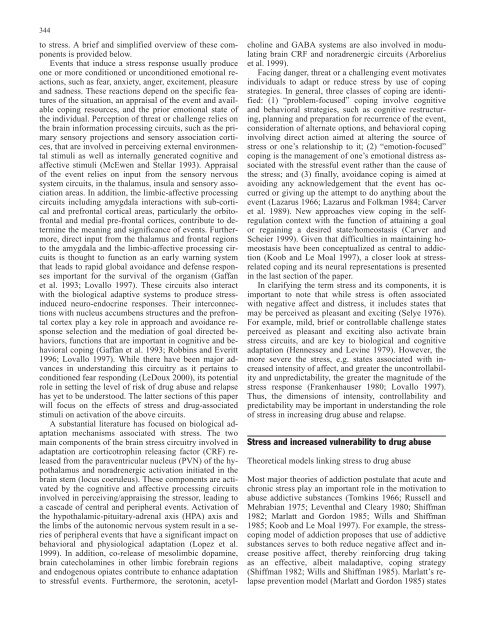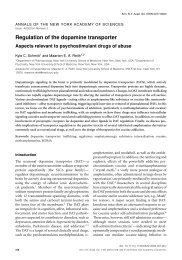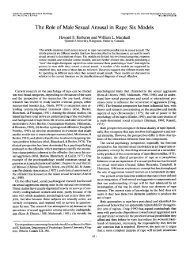How does stress increase risk of drug abuse - Addiction Research ...
How does stress increase risk of drug abuse - Addiction Research ...
How does stress increase risk of drug abuse - Addiction Research ...
Create successful ePaper yourself
Turn your PDF publications into a flip-book with our unique Google optimized e-Paper software.
344<br />
to <strong>stress</strong>. A brief and simplified overview <strong>of</strong> these components<br />
is provided below.<br />
Events that induce a <strong>stress</strong> response usually produce<br />
one or more conditioned or unconditioned emotional reactions,<br />
such as fear, anxiety, anger, excitement, pleasure<br />
and sadness. These reactions depend on the specific features<br />
<strong>of</strong> the situation, an appraisal <strong>of</strong> the event and available<br />
coping resources, and the prior emotional state <strong>of</strong><br />
the individual. Perception <strong>of</strong> threat or challenge relies on<br />
the brain information processing circuits, such as the primary<br />
sensory projections and sensory association cortices,<br />
that are involved in perceiving external environmental<br />
stimuli as well as internally generated cognitive and<br />
affective stimuli (McEwen and Stellar 1993). Appraisal<br />
<strong>of</strong> the event relies on input from the sensory nervous<br />
system circuits, in the thalamus, insula and sensory association<br />
areas. In addition, the limbic-affective processing<br />
circuits including amygdala interactions with sub-cortical<br />
and prefrontal cortical areas, particularly the orbit<strong>of</strong>rontal<br />
and medial pre-frontal cortices, contribute to determine<br />
the meaning and significance <strong>of</strong> events. Furthermore,<br />
direct input from the thalamus and frontal regions<br />
to the amygdala and the limbic-affective processing circuits<br />
is thought to function as an early warning system<br />
that leads to rapid global avoidance and defense responses<br />
important for the survival <strong>of</strong> the organism (Gaffan<br />
et al. 1993; Lovallo 1997). These circuits also interact<br />
with the biological adaptive systems to produce <strong>stress</strong>induced<br />
neuro-endocrine responses. Their interconnections<br />
with nucleus accumbens structures and the prefrontal<br />
cortex play a key role in approach and avoidance response<br />
selection and the mediation <strong>of</strong> goal directed behaviors,<br />
functions that are important in cognitive and behavioral<br />
coping (Gaffan et al. 1993; Robbins and Everitt<br />
1996; Lovallo 1997). While there have been major advances<br />
in understanding this circuitry as it pertains to<br />
conditioned fear responding (LeDoux 2000), its potential<br />
role in setting the level <strong>of</strong> <strong>risk</strong> <strong>of</strong> <strong>drug</strong> <strong>abuse</strong> and relapse<br />
has yet to be understood. The latter sections <strong>of</strong> this paper<br />
will focus on the effects <strong>of</strong> <strong>stress</strong> and <strong>drug</strong>-associated<br />
stimuli on activation <strong>of</strong> the above circuits.<br />
A substantial literature has focused on biological adaptation<br />
mechanisms associated with <strong>stress</strong>. The two<br />
main components <strong>of</strong> the brain <strong>stress</strong> circuitry involved in<br />
adaptation are corticotrophin releasing factor (CRF) released<br />
from the paraventricular nucleus (PVN) <strong>of</strong> the hypothalamus<br />
and noradrenergic activation initiated in the<br />
brain stem (locus coeruleus). These components are activated<br />
by the cognitive and affective processing circuits<br />
involved in perceiving/appraising the <strong>stress</strong>or, leading to<br />
a cascade <strong>of</strong> central and peripheral events. Activation <strong>of</strong><br />
the hypothalamic-pituitary-adrenal axis (HPA) axis and<br />
the limbs <strong>of</strong> the autonomic nervous system result in a series<br />
<strong>of</strong> peripheral events that have a significant impact on<br />
behavioral and physiological adaptation (Lopez et al.<br />
1999). In addition, co-release <strong>of</strong> mesolimbic dopamine,<br />
brain catecholamines in other limbic forebrain regions<br />
and endogenous opiates contribute to enhance adaptation<br />
to <strong>stress</strong>ful events. Furthermore, the serotonin, acetyl-<br />
choline and GABA systems are also involved in modulating<br />
brain CRF and noradrenergic circuits (Arborelius<br />
et al. 1999).<br />
Facing danger, threat or a challenging event motivates<br />
individuals to adapt or reduce <strong>stress</strong> by use <strong>of</strong> coping<br />
strategies. In general, three classes <strong>of</strong> coping are identified:<br />
(1) “problem-focused” coping involve cognitive<br />
and behavioral strategies, such as cognitive restructuring,<br />
planning and preparation for recurrence <strong>of</strong> the event,<br />
consideration <strong>of</strong> alternate options, and behavioral coping<br />
involving direct action aimed at altering the source <strong>of</strong><br />
<strong>stress</strong> or one’s relationship to it; (2) “emotion-focused”<br />
coping is the management <strong>of</strong> one’s emotional di<strong>stress</strong> associated<br />
with the <strong>stress</strong>ful event rather than the cause <strong>of</strong><br />
the <strong>stress</strong>; and (3) finally, avoidance coping is aimed at<br />
avoiding any acknowledgement that the event has occurred<br />
or giving up the attempt to do anything about the<br />
event (Lazarus 1966; Lazarus and Folkman 1984; Carver<br />
et al. 1989). New approaches view coping in the selfregulation<br />
context with the function <strong>of</strong> attaining a goal<br />
or regaining a desired state/homeostasis (Carver and<br />
Scheier 1999). Given that difficulties in maintaining homeostasis<br />
have been conceptualized as central to addiction<br />
(Koob and Le Moal 1997), a closer look at <strong>stress</strong>related<br />
coping and its neural representations is presented<br />
in the last section <strong>of</strong> the paper.<br />
In clarifying the term <strong>stress</strong> and its components, it is<br />
important to note that while <strong>stress</strong> is <strong>of</strong>ten associated<br />
with negative affect and di<strong>stress</strong>, it includes states that<br />
may be perceived as pleasant and exciting (Selye 1976).<br />
For example, mild, brief or controllable challenge states<br />
perceived as pleasant and exciting also activate brain<br />
<strong>stress</strong> circuits, and are key to biological and cognitive<br />
adaptation (Hennessey and Levine 1979). <strong>How</strong>ever, the<br />
more severe the <strong>stress</strong>, e.g. states associated with <strong>increase</strong>d<br />
intensity <strong>of</strong> affect, and greater the uncontrollability<br />
and unpredictability, the greater the magnitude <strong>of</strong> the<br />
<strong>stress</strong> response (Frankenhauser 1980; Lovallo 1997).<br />
Thus, the dimensions <strong>of</strong> intensity, controllability and<br />
predictability may be important in understanding the role<br />
<strong>of</strong> <strong>stress</strong> in increasing <strong>drug</strong> <strong>abuse</strong> and relapse.<br />
Stress and <strong>increase</strong>d vulnerability to <strong>drug</strong> <strong>abuse</strong><br />
Theoretical models linking <strong>stress</strong> to <strong>drug</strong> <strong>abuse</strong><br />
Most major theories <strong>of</strong> addiction postulate that acute and<br />
chronic <strong>stress</strong> play an important role in the motivation to<br />
<strong>abuse</strong> addictive substances (Tomkins 1966; Russell and<br />
Mehrabian 1975; Leventhal and Cleary 1980; Shiffman<br />
1982; Marlatt and Gordon 1985; Wills and Shiffman<br />
1985; Koob and Le Moal 1997). For example, the <strong>stress</strong>coping<br />
model <strong>of</strong> addiction proposes that use <strong>of</strong> addictive<br />
substances serves to both reduce negative affect and <strong>increase</strong><br />
positive affect, thereby reinforcing <strong>drug</strong> taking<br />
as an effective, albeit maladaptive, coping strategy<br />
(Shiffman 1982; Wills and Shiffman 1985). Marlatt’s relapse<br />
prevention model (Marlatt and Gordon 1985) states










